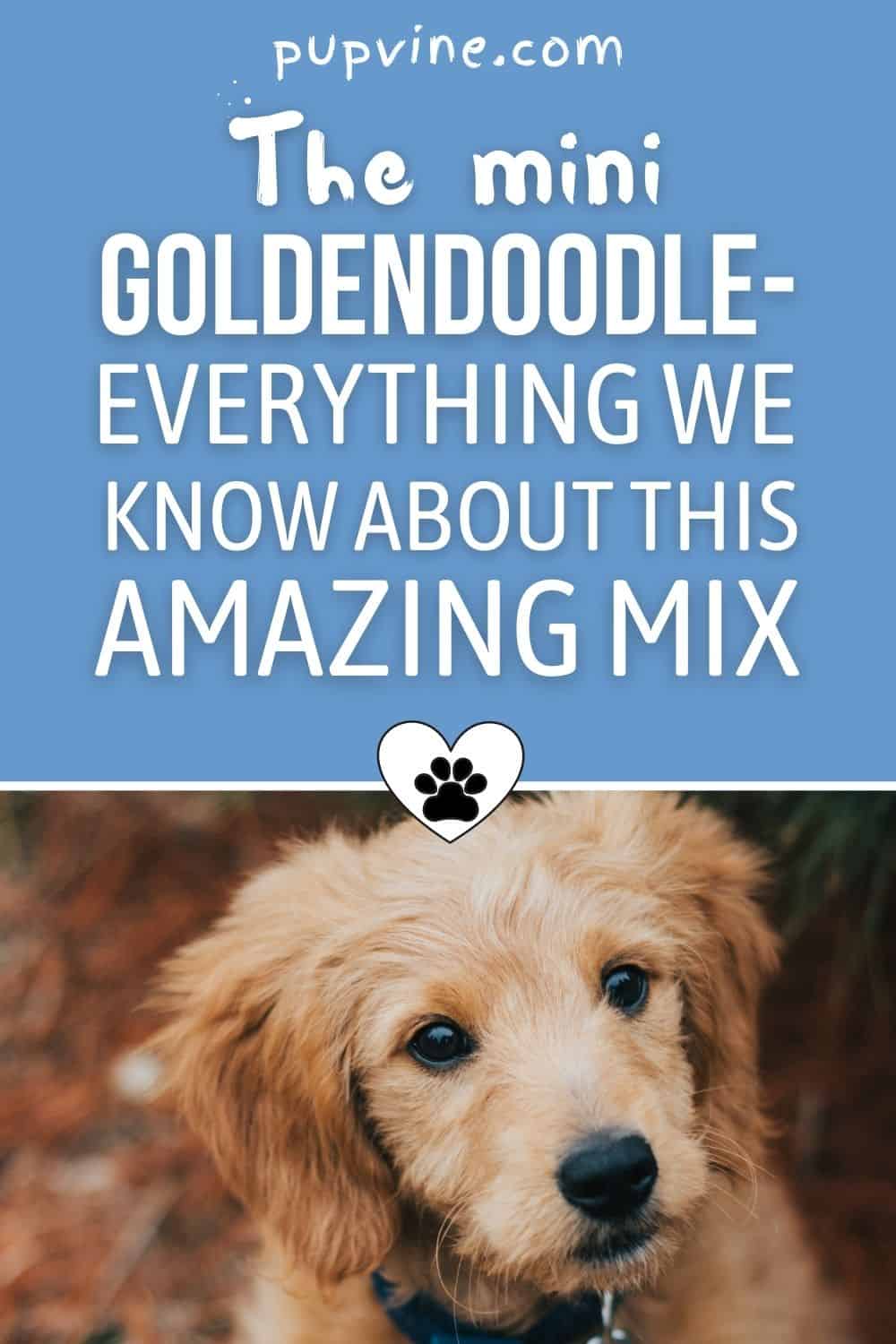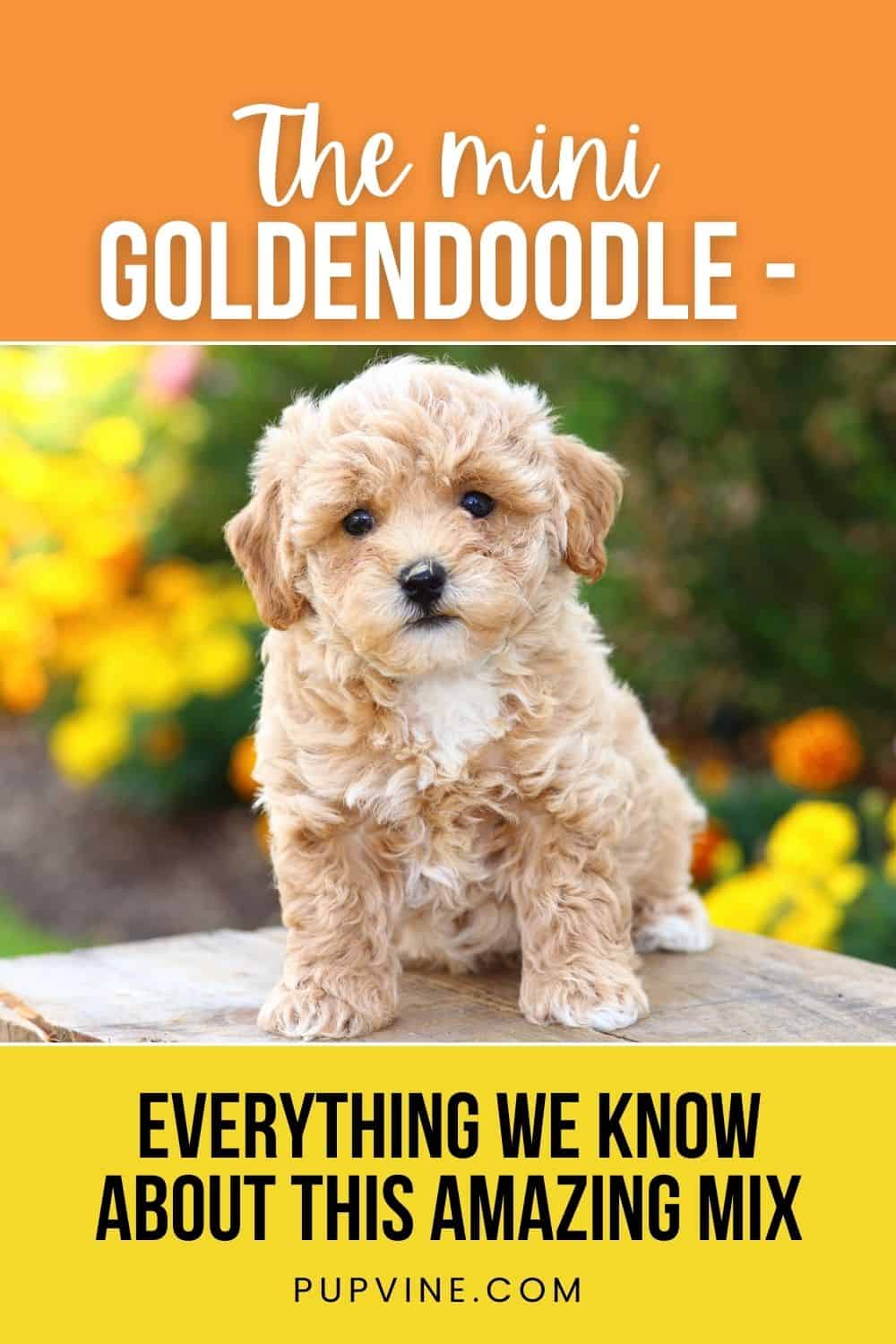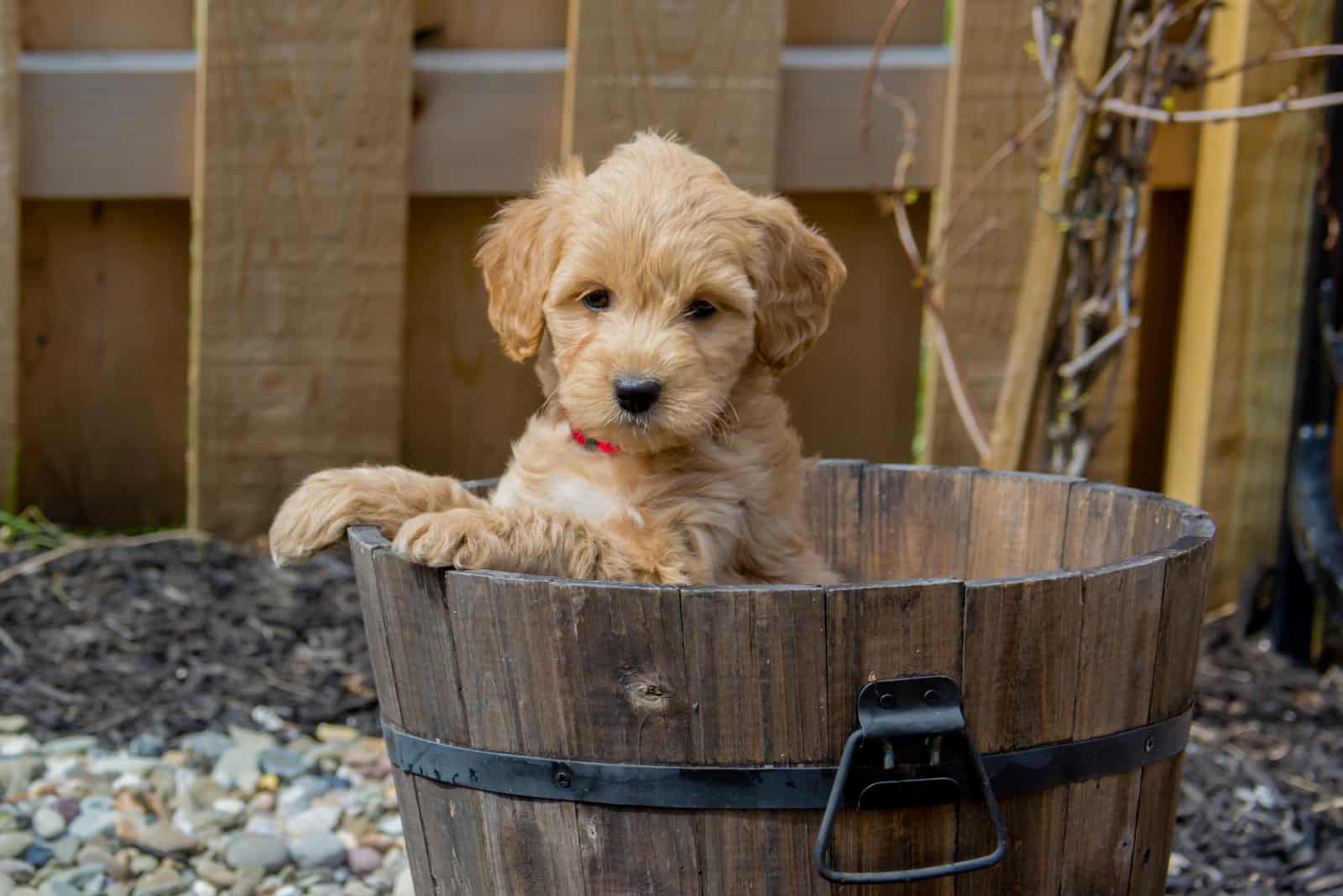There are three possible reasons for wanting to get yourself a Mini Goldendoodle:
• They’re pretty small dogs that don’t take up much space
• They’re a great choice if you have mild allergies
• They’re the friendliest, most affectionate, playful, and sweet-natured dogs ever!
If you’re considering one for yourself and want to know more, we’ve got all the information you need.
Let’s begin by asking a fundamental question…
What Is A Mini Goldendoodle?
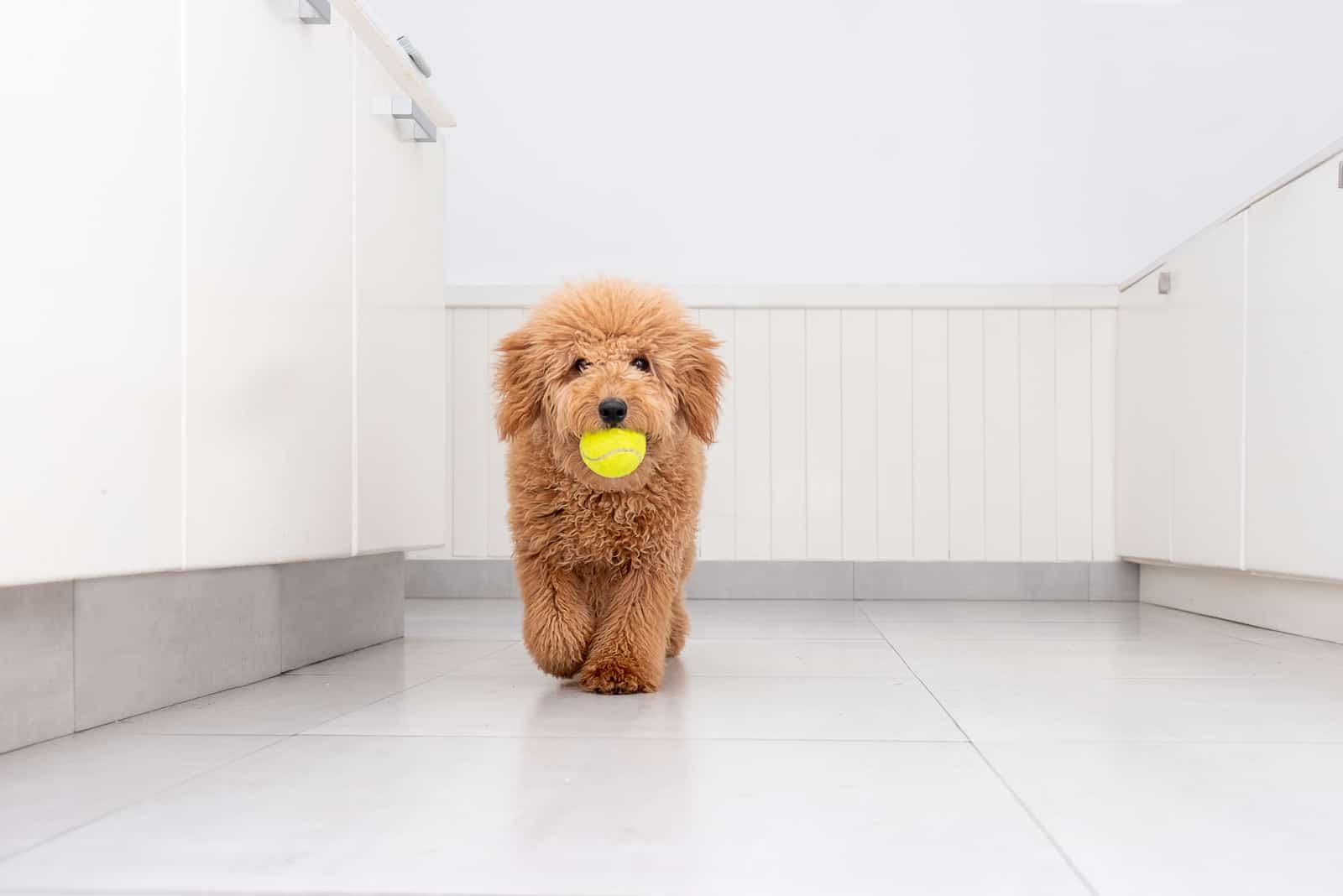
A Miniature Goldendoodle is a mixed breed dog that’s a cross between a purebred Golden Retriever and the Miniature Poodle.
That’s right – the faithful, affectionate, loving, and playful Retriever mixed with the super-smart, mischievous, goofy Poodle!
It’s a wonderful mix that captures both dog breeds perfectly. What more could any dog lover ask for in a furry companion?
These aren’t purebred dogs, so they can’t be registered with organizations like the American Kennel Club (AKC) as they don’t recognize crossbreeds. This means they can’t be entered into AKC dog shows and events, but this fact hasn’t deterred thousands of dog lovers from buying them.
Sadly, there’s a lot of snobbery regarding the topic of hybrid dogs. Even that term, hybrid dogs, gets people all bent out of shape. Some fans of pure breeds refer to mixed breeds as mutts, and it’s meant as an insult.
The good news is that designer dogs, including the Goldendoodle, are here to stay, whatever the kennel clubs think.
On that note, let’s see what these tiny beauties are like to live with.
The Mini Golden’s Temperament
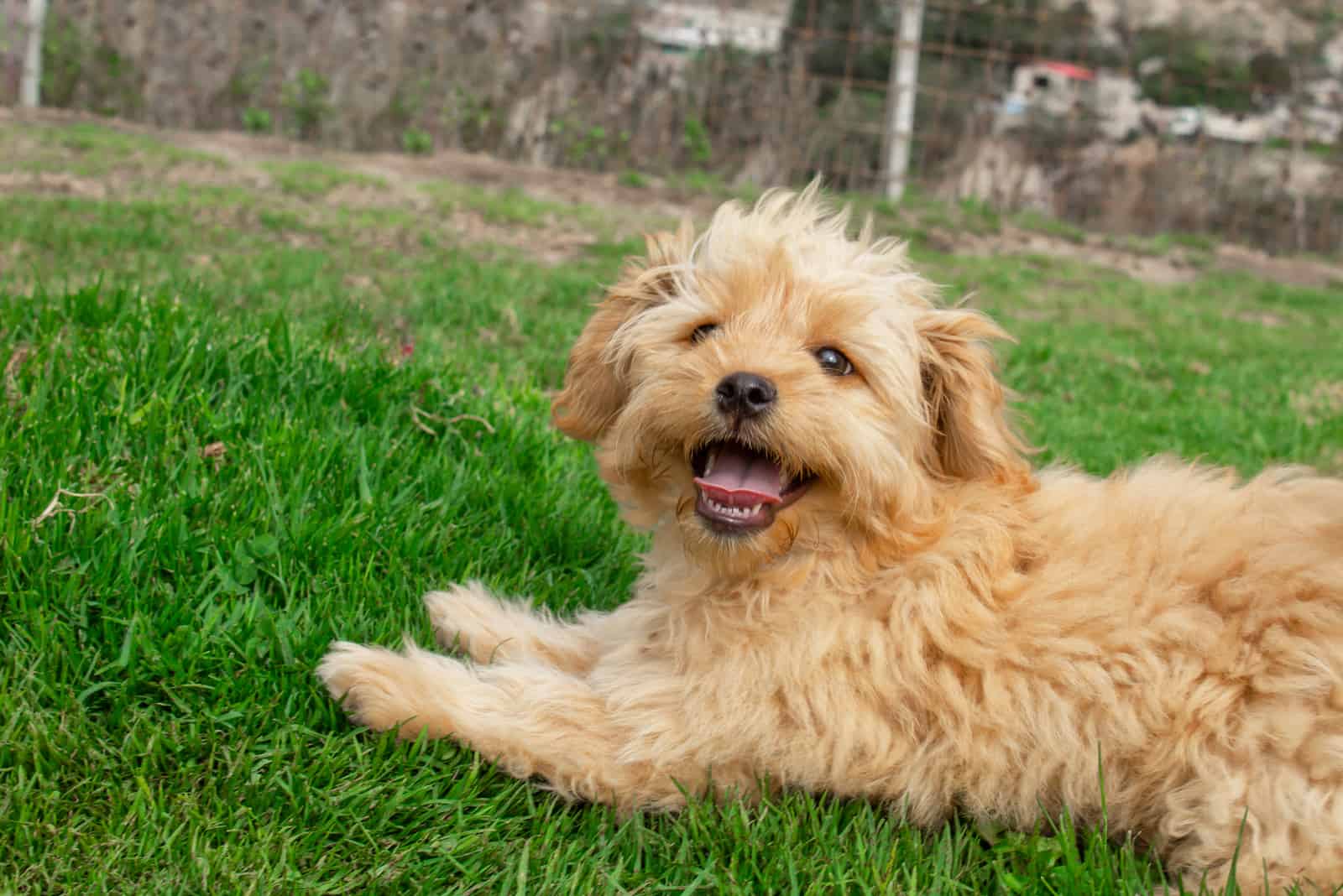
Are you looking for a cuddle buddy? Then this is the dog for you! When it comes to sociability, this dog is hard to beat.
Mini Goldens are perfect family pets as they are happy around kids* and there’s not an ounce of aggression in them.
*Though it’s always best to keep a watchful eye on kids and dogs together for safety’s sake.
These little pooches have the sharp-minded intelligence of the Poodle, along with the fun-loving playfulness of both parent breeds.
They are endlessly loyal and faithful and love nothing better than your company, attention, and affection.
Because of this, they are seriously prone to separation anxiety; leaving your Mini Golden alone for more than a few hours will break its heart, and your home may suffer as a result! This isn’t a breed for anyone who works long hours and will leave the dog at home by itself all day long.
An Active Dog
Although they’ll happily settle by your side or on your lap while you watch TV, this is no couch potato. Mini Goldens are high-energy dogs, despite their size, and they love to be active, either walking, running, swimming, or playing.
They need roughly between 30 and 60 minutes of daily exercise to keep them fit and healthy, along with adequate mental stimulation to stop them from being bored and frustrated.
The Miniature Goldendoodle excels when it comes to trainability because it is blessed with intelligence and a strong desire to please you. This is why Standard Goldendoodles are often used as service dogs and therapy dogs, and the mini version mirrors this quality in every way.
It also makes an ideal family dog!
Now let’s look at how big they might get.
How Big Does a Mini Goldendoodle Get?
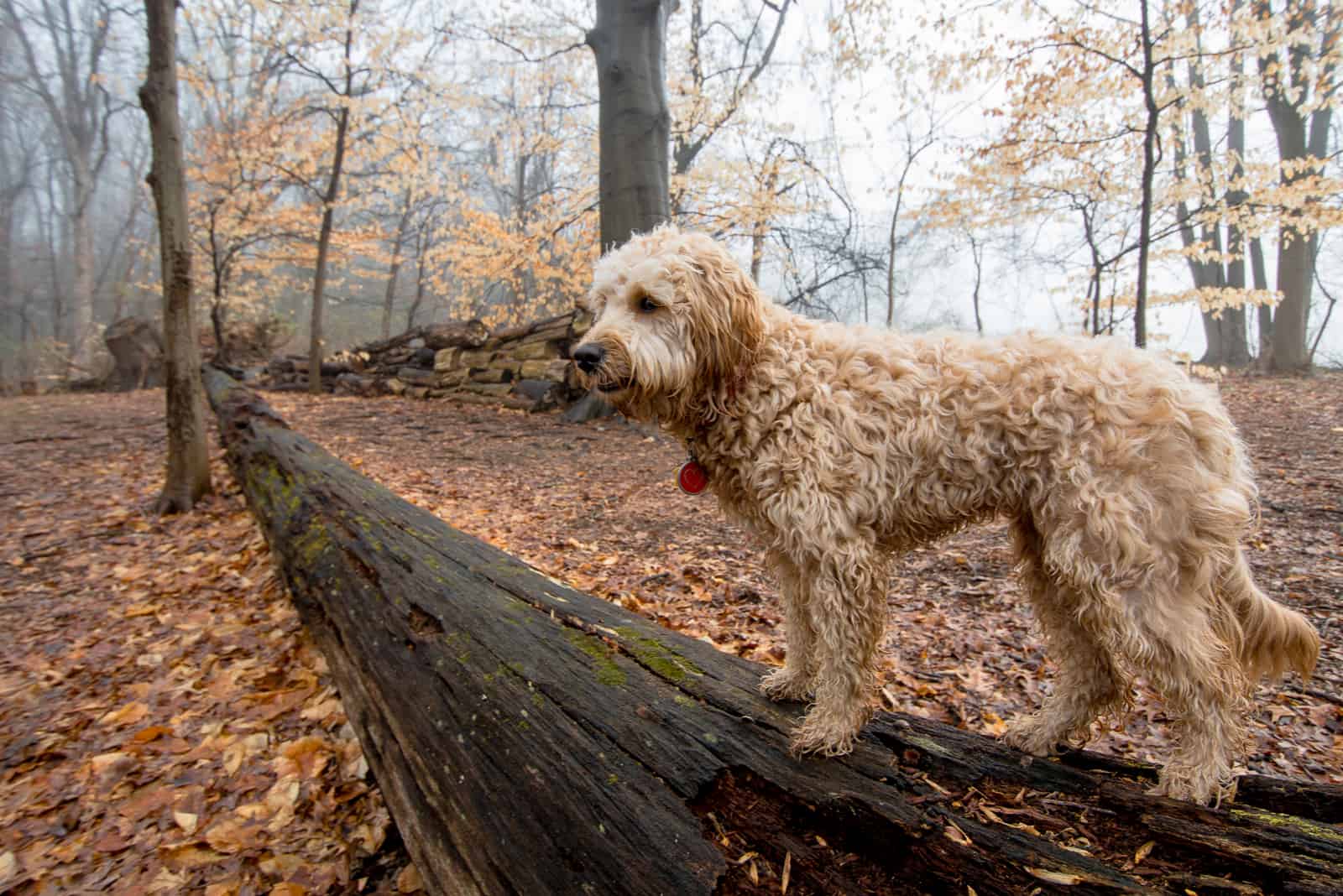
It’s confusing when different websites throw out various names and sizes, but this is precisely what you’ll find when you look for information about Mini Goldendoodles online. And some of these are plain wrong!
Many people use the terms petite, moyen, petite-mini, toy, mini, or teacup to describe dogs of the same size. Others state that mini, toy, and medium Goldendoodle are the same things, and some sites don’t mention some of these sizes at all! Are you confused yet?
On the whole, it’s best to stick to the four main sizes: Standard, Medium, Miniature, and Toy.
Even so, there has to be some flexibility in the size charts as it isn’t easy to predict exactly how big your pooch will be when it’s stopped growing.
However, we’ll try to keep things simple:
A fully-grown Miniature Goldendoodle typically measures between 13 and 17 inches at the shoulder.
This puts the Mini Golden in the Goldilocks Dog bracket, meaning that it’s not too big or too small, but is just the right size!
Goldendoodle Size Chart
Here’s a handy chart to help us get a handle on the relative sizes of each type of Goldendoodle and the miniature version’s place in this:
The largest size (Standard Goldendoodle) is produced by crossing a purebred Standard Poodle with a purebred Golden Retriever. The Medium and Miniature types are a cross of the Miniature Poodle and the Retriever. As some dogs are naturally smaller, they will be miniature rather than medium.
Finally, those in the smallest category are produced by crossing the Toy Poodle with the Golden Retriever.
Any dog smaller than this will potentially have severe health problems. As a rule, it’s best to avoid anyone selling Teacup Goldendoodles: you’ll pay twice as much for a tiny dog that will cost even more in heavy vet bills throughout its life.
No reputable breeder advertises or sells Teacup dogs.
Mini Goldendoodle Weight
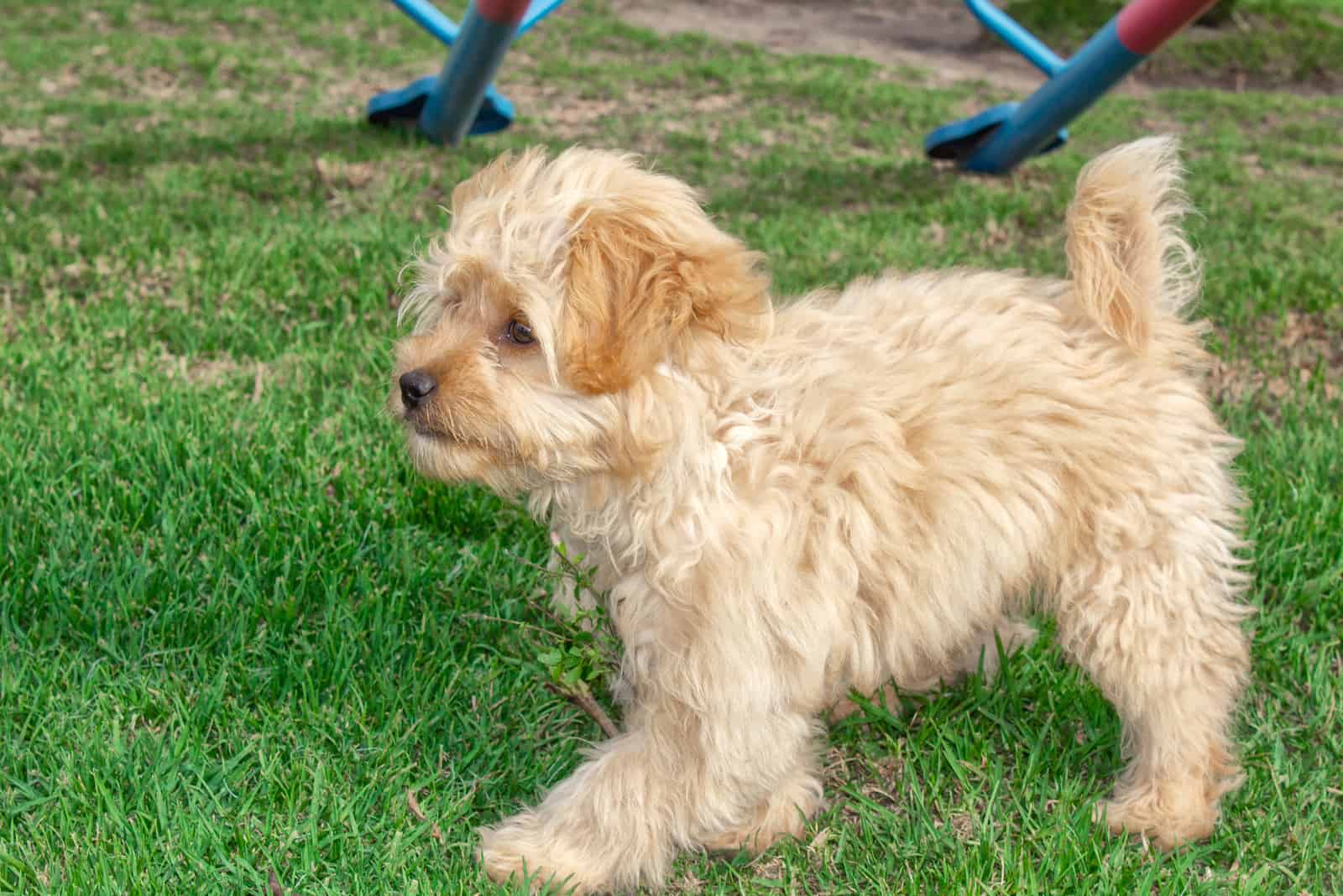
A healthy full-grown adult Mini Goldendoodle should weigh somewhere between 15 and 30 pounds.
As always, females tend to be smaller and lighter, and their height and weight should always be proportionate.
Obesity is a significant problem, with around half of all pet dogs in the US classified as overweight or obese. While it’s understandable that dog lovers want to spoil their furry pals, all that extra weight will shorten their life considerably, potentially by as much as three years.
Food-motivated dogs are more at risk, as it is easy to use this trait to your advantage. However, you may be storing up health problems for the future!
By all means, treat your puppy, but use healthy foods to do so.
Also, make sure they have a healthy, balanced diet and enough exercise to match their energy level.
Training Your Mini Doodle

Most dog breeds are intelligent, but some have the edge over others.
For example, the Poodle is brighter than the average dog, with a sharp mind that’s always alert. Golden Retrievers are pretty clever, too, making this designer dog one of the most quick-witted canines going!
Sometimes, training an intelligent breed can be a challenge, as they tend to be willful and stubborn. Breeds like the Aussie Sheepdog, for example, will try to outthink you, and many are capable of doing so! Before you know it, they’ll have you doing what they want, before you even realize it.
Read More: Mini Doodle Breeds
Eager To Please!
However, you’re in luck with the Goldendoodle, as this breed lives to please you. They are eager to learn and will hang on to your every word.
As with all dogs, positive reinforcement is the best way to get results. This means rewarding your dog for getting it right instead of punishing it when it doesn’t comply.
Smacking your dog is rarely productive and only serves to make them afraid of you. This is no longer regarded as an acceptable training method by most experts these days, which is exactly as it should be.
Reward-based training is effective and forms a better relationship with your furry friend.
Mini Goldendoodle Colors
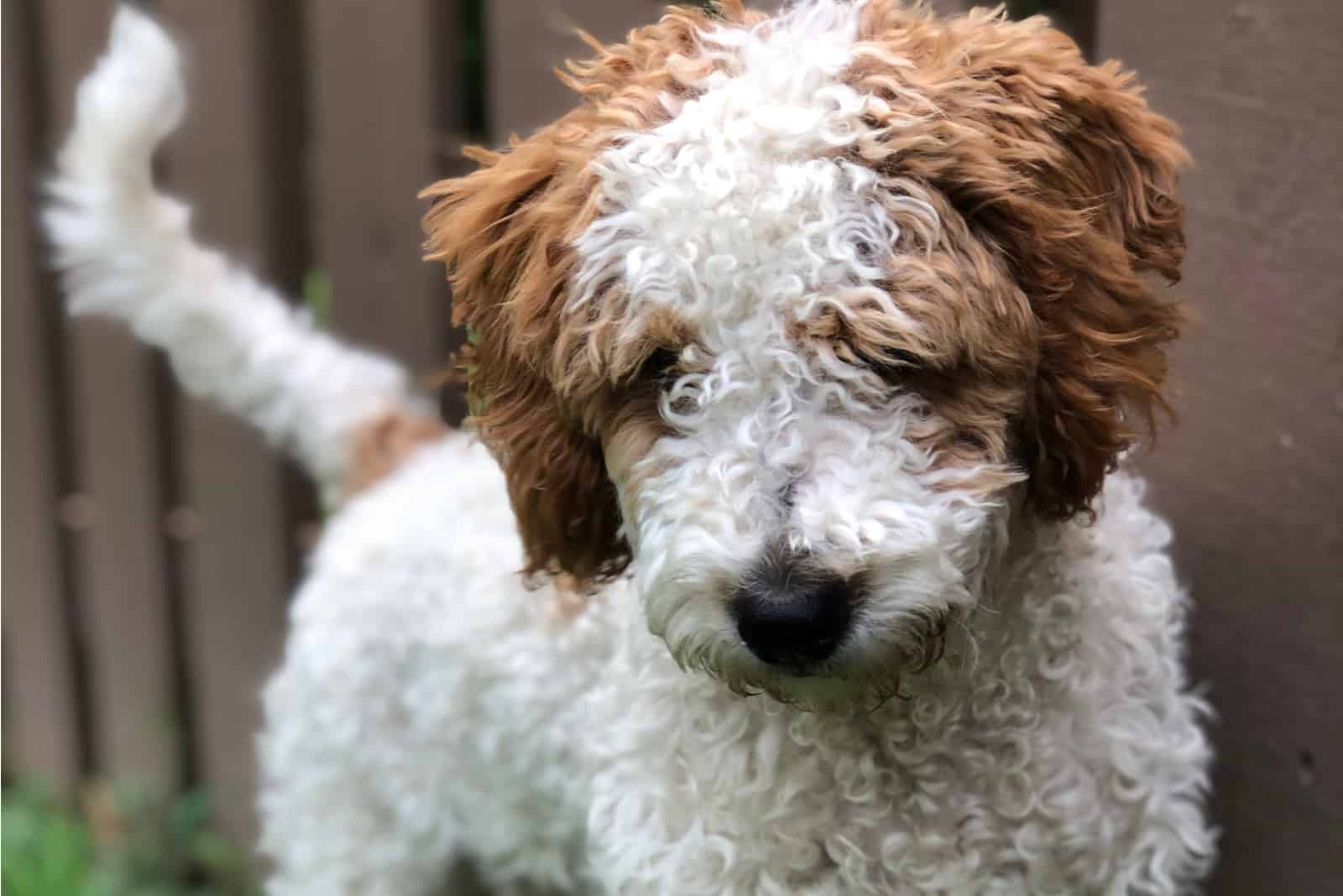
Don’t let that name fool you: they’re not only golden, but they also come in various colors!
In fact, as breeders discover more about DNA and coat color genetics, the range of colors is becoming virtually infinite.
The Goldendoodle Color Palette
Meanwhile, here are some of the colors you might see:
• Black
• Cream
• Black & white
• Red
• Apricot
• Fawn
• Gray
• White
• Tan
• Phantom
• parti-colored
Some of these are rare colors, so you may need to pay more for them* and you also might have to wait a while. Predicting puppy colors is never easy!
If you’re not fussy about the color, you’ll most likely get a Mini Goldendoodle puppy in a shade of fawn or brown.
*Even so, never be too quick to pay well over the odds for a ‘rare’ color! Good breeders don’t hike their prices too high for unique colors, and they never advertise their pups as such.
Mini Goldendoodle F1B
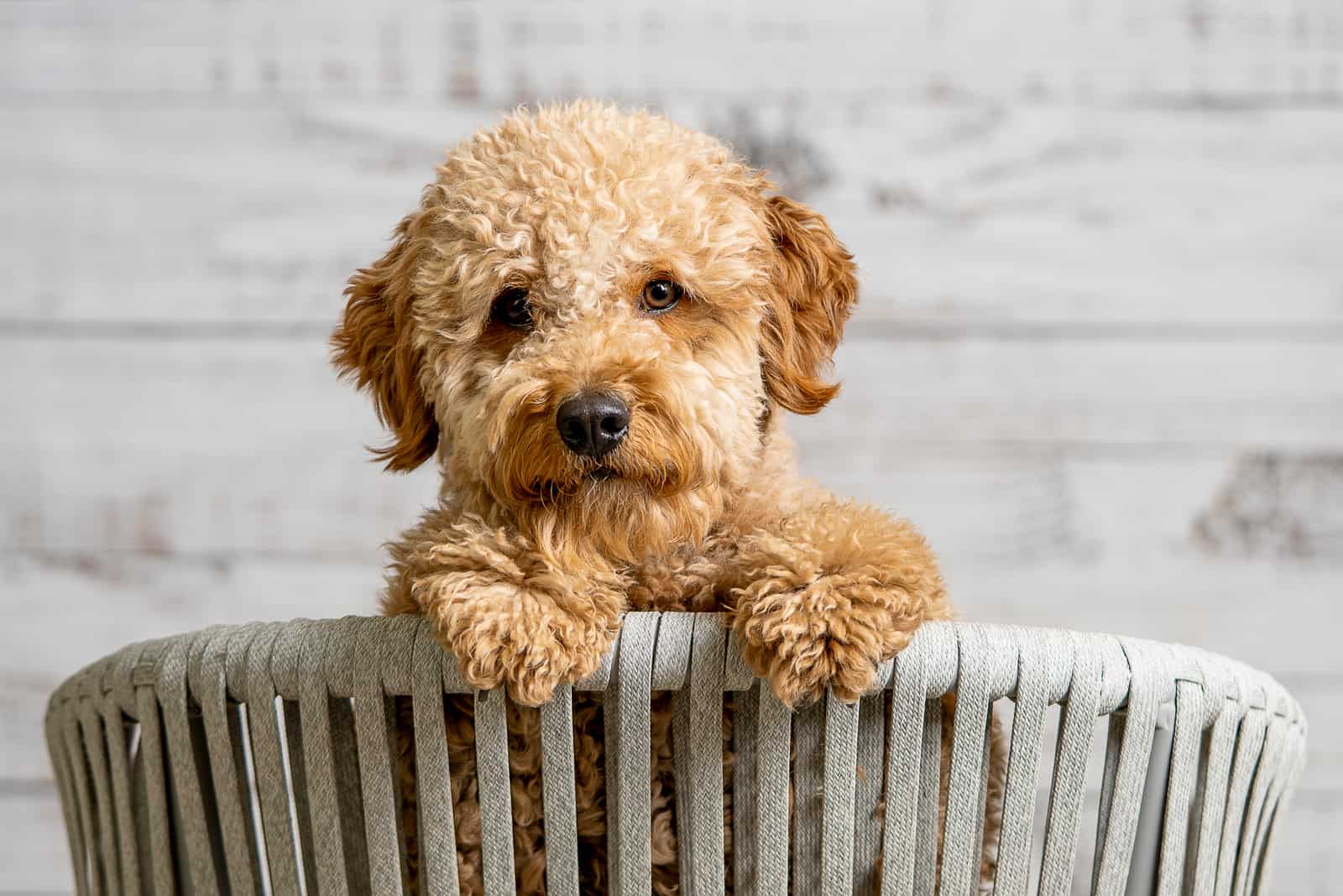
You may have seen these codes when visiting doggy websites and wondered what they mean. You’ll see f1, f1b, f2, f2b Goldendoodle, and so on, but what does it all mean?
Well, it’s actually pretty straightforward!
When the breeder mates a mini Poodle with a Golden Retriever, they get f1 pups. That means first generation, where the puppies are a 50:50 mix of either breed.
An f1b is back-crossed to a parent breed. For example, a purebred Golden Retriever may be mated with an f1 Goldendoodle, resulting in a cross that’s 25% Retriever and 75% Poodle.
For our purposes, this would be a Golden Retriever crossed with an f1 Mini Goldendoodle, producing the f1b Mini Goldendoodle.
Simple, right?
This isn’t just an experiment: breeders do this to enhance specific traits, in this case, the hypoallergenic Goldendoodle coat. As Golden Retrievers aren’t hypoallergenic, there’s a slim chance that the hybrid pups will favor this parent over the Poodle.
F1b puppies are almost certain to inherit the allergy-friendly coat, making them a better choice for people with mild allergies.
Mini Goldendoodle Breeders
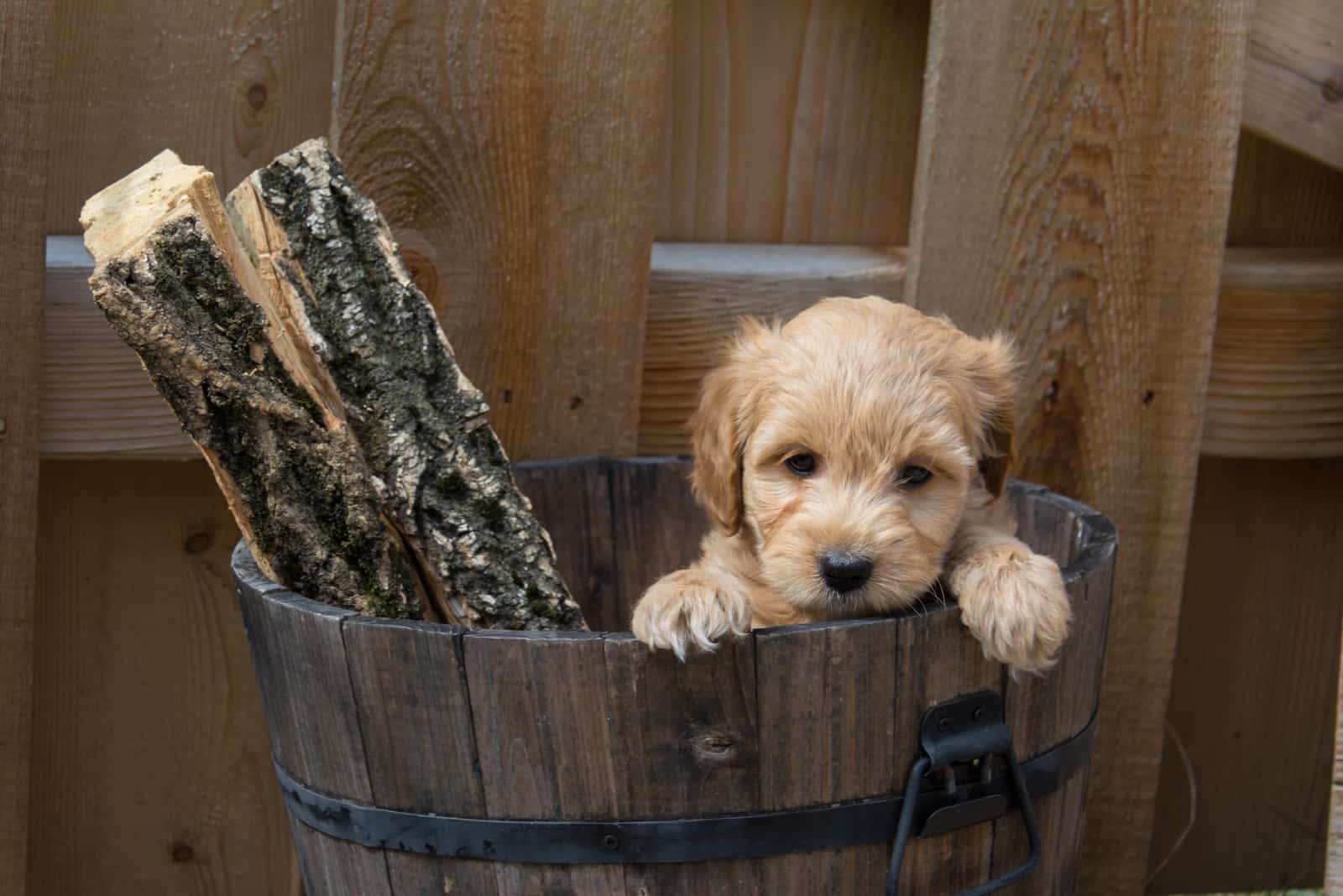
As always, it’s best to find a reputable breeder.
Dog breeding requires specialist knowledge and expertise – it isn’t a case of simply putting a male and female dog together!
Good breeders usually have a background of working with and owning animals long before they start their breeding business. They invest a great deal of money, time, and effort in producing healthy puppies, often without much profit. Their work really is a labor of love.
This is how you can distinguish between a good and a bad breeder: the best ones will run tests on the parent dogs for genetic health issues and will ensure their parent dogs are kept in excellent condition with a healthy diet. These dogs are often part of the family.
Other breeders don’t perform any tests and keep the dogs in kennels, away from the home. They are deprived of the love and companionship of humans, which is something all dogs crave, the Goldendoodle in particular.
All the best breeders will invite you to meet them onsite if your application is successful. This gives you an excellent opportunity to assess the breeder, check out the site, and examine the parent dogs.
It also gives the breeder a chance to see whether you are a good match for their pup!
How Expensive Is a Mini Goldendoodle?
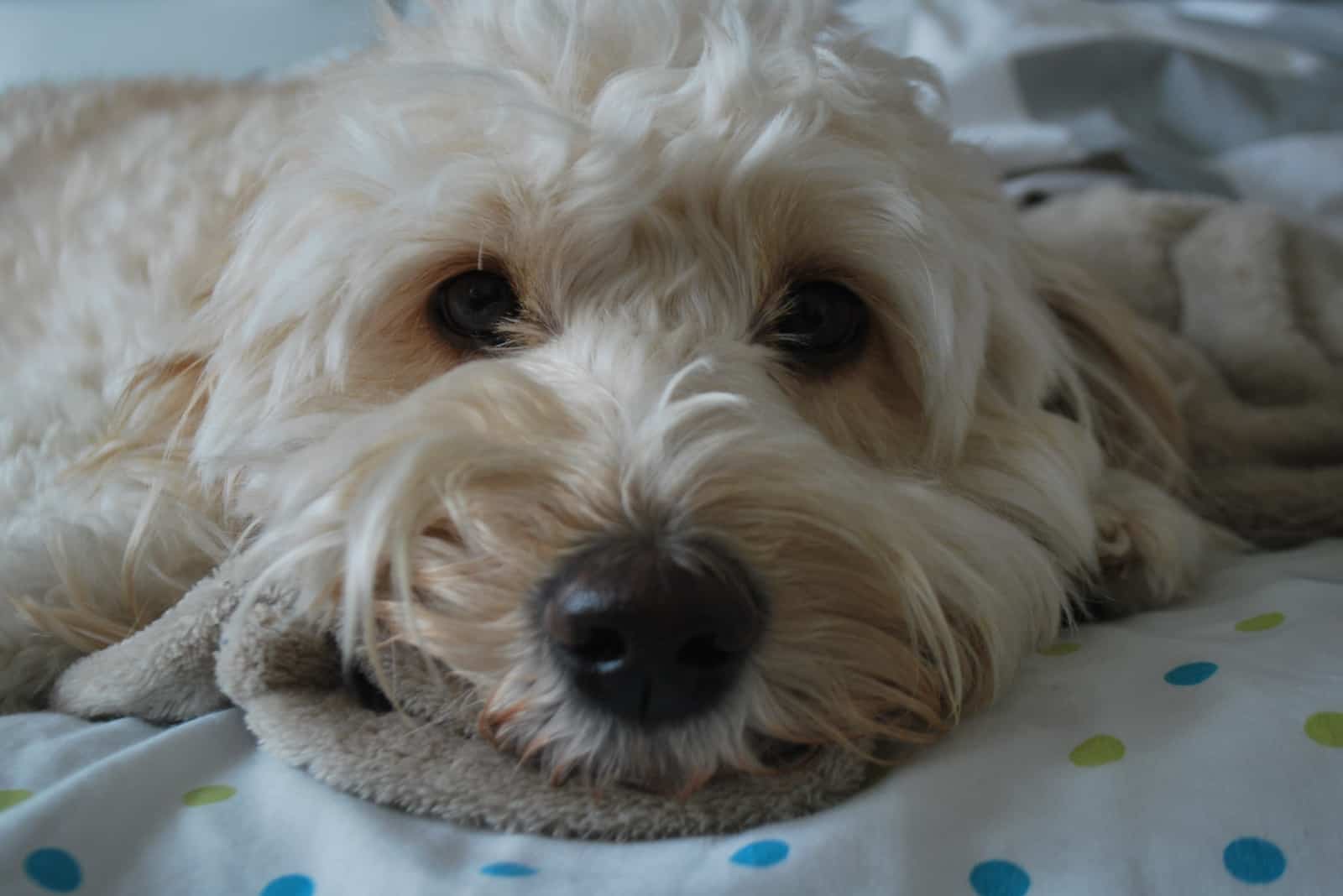
How much do Miniature Goldendoodles cost? As always, the answer isn’t straightforward!
Prices start from roughly $1,500 and run as high as $6,000.
We know what you’re thinking: why is there such a big price difference? After all, who wants to pay more than they have to?
Factors Affecting Price
There are several factors affecting puppy prices, as you can see here:
• Location – Oddly enough, those in northern states are likely to pay more for their pups as prices tend to be higher than in the south. One reason could be that there are more dog breeders in the south, so the competition keeps prices down, but this is only a theory.
• Supply and demand – The more demand there is for a particular breed, the higher the price. Sorry guys, that’s the nature of business!
• Sex – Some breeders charge more for girl dogs! This particular one is tough to swallow, as it’s based on the fact that female dogs traditionally had ‘breeding potential.’ Now that responsible dog ownership is encouraged, with breeders enforcing spay/neuter agreements as a condition of sale, there really shouldn’t be any price difference. It’s worth raising this point with a breeder before buying.
• Breeder’s reputation – These guys take great pains to build their reputation. They invest blood, sweat, and tears (literally!) to ensure their dogs are healthy and happy. The better the reputation, the higher the prices, because they earned it! People trust them because of this, and most are happy to pay more in the knowledge that their pup is of exceptional quality.
• Extras – What comes with the pup? A puppy pack with food samples, toys, a blanket, leash, collar, and treats? Is the dog microchipped, vaccinated, and de-wormed? Was it checked out by a vet to make sure it is healthy? All of these things add to the breeder’s expenses, and they must recover at least some of it.
• Health testing – Genetic testing can be pricey! Average prices run from $60 to $200 for a single test. Some parent dogs receive two or three tests to ensure they are fit for breeding.
• Training and socialization methods – The best breeders use Early Neurological Stimulation (also called the Super Dog program) or Puppy Culture to train and socialize their pups. This is proven to boost their immune system and metabolism and make them more confident and less prone to stress as adults!
On top of all this, breeders have various expenses. It typically costs between $1,600 and $8,000 to produce a single litter of healthy pups.
Mini Goldendoodles For Adoption
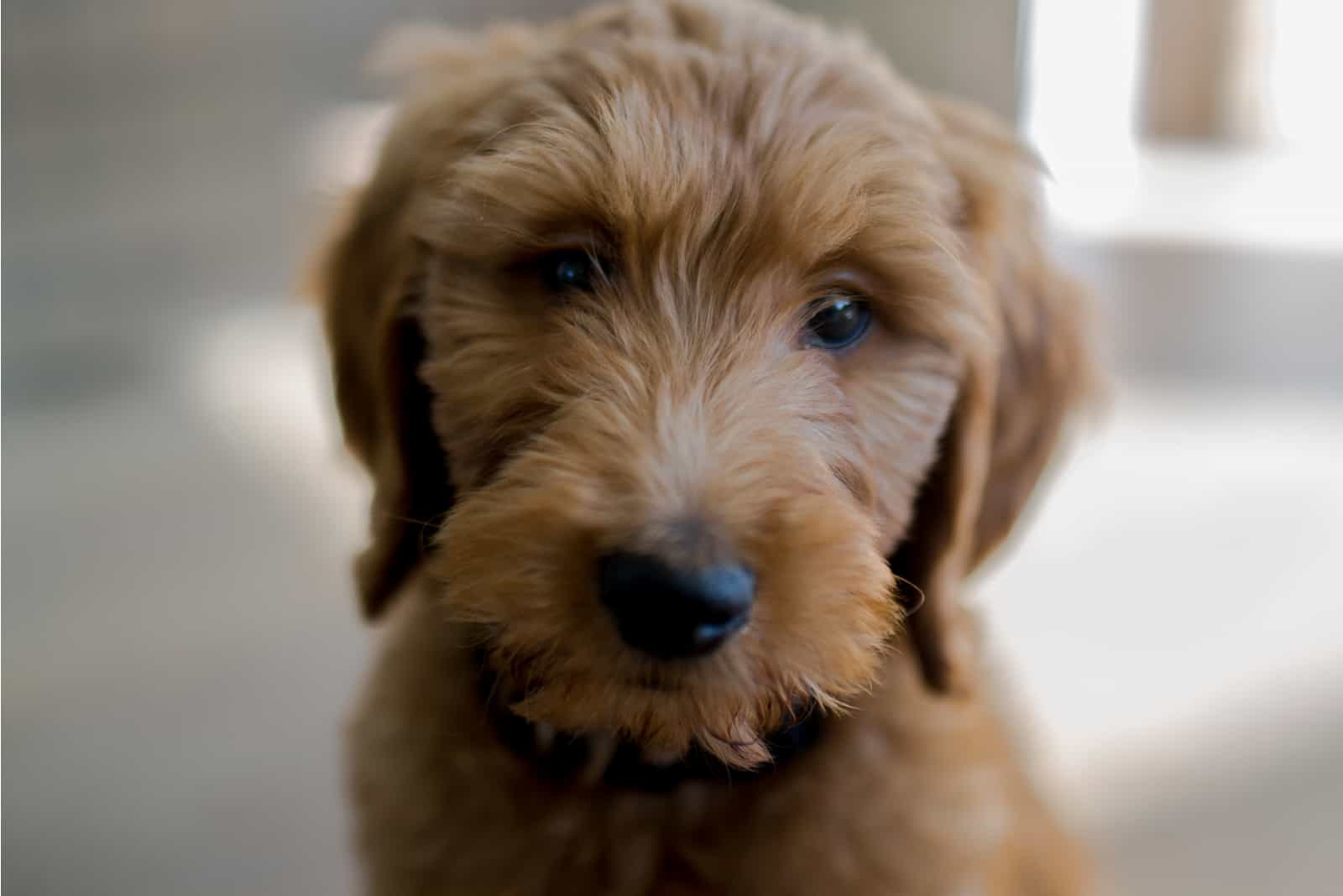
Adopting instead of buying is always a great idea, as many thousands of dogs in shelters need homes. Most will be at least two years old, but there’s a slim chance you may find a younger pup.
Although Doodle dogs are hugely popular, there’s still a good chance of finding one through a rescue group or animal shelter, especially right now. You could increase your chances by considering the Labradoodle, which is a similarly fantastic pooch!
During the Covid-19 lockdowns, millions of people decided they wanted a family pet, and many chose to get a puppy. Sadly, now things are getting back to normal, thousands of these new dog owners have decided that it was a mistake.
As a result, dog rescues and shelters are filled with unwanted dogs of all kinds.
Less Expensive Than A Breeder
Adopting a Mini Goldendoodle dog is much cheaper than buying from a breeder: adoption fees generally average between $50 and $200 but may go as high as $500, depending on the organization.
You may find rescue groups dedicated to helping Doodles. Some that focus on purebred dogs will also include mixed breeds in their work (so, a Poodle or a Golden Retriever rescue group may also deal with Goldendoodles).
If you want a Mini Doodle of your own, your local rescue group is the best place to start your search!
Are Mini Goldens Hypoallergenic?
Yes, they are hypoallergenic.
But let’s pause a moment to explain, as this term causes all kinds of confusion!
Goldendoodles inherit curly coats from their Poodle parents, a dog famous for being allergy-friendly. This coat is very low shedding (not non-shedding, as such a dog does not exist!), and the dog doesn’t produce much dander.
As a result, the Miniature Goldendoodle is less likely to trigger an allergy than some other breeds. And that’s what hypoallergenic means: less likely to cause an allergic reaction.
So, when you see phrases like, no dog can be truly hypoallergenic, skip past it quickly as the writer clearly doesn’t understand the word. Sadly, you’ll find this kind of thing everywhere, even on some kennel club and breeder’s websites!
The bottom line is that these dogs are potentially better for allergy sufferers. However, there are no guarantees: it all depends on each individual dog and the severity of your allergy.
Mini Goldendoodle Health Problems
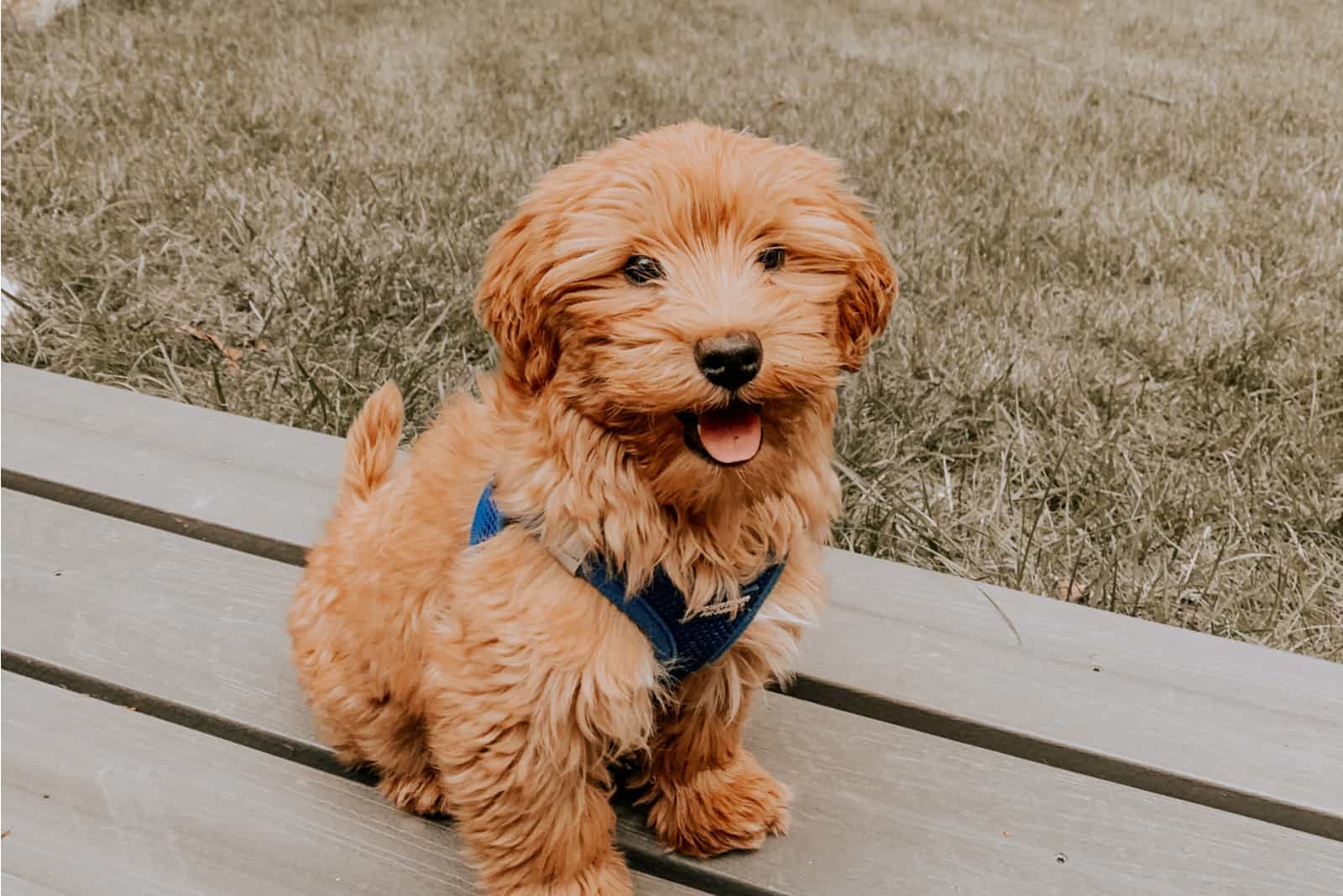
These Doodle dogs aren’t immune to the common health issues that other breeds face, though they are generally more robust and healthy because of hybrid vigor. It’s a proven fact that mixed breeds often avoid many of the usual genetic conditions than purebred dogs get because of the injection of new genes.
Even so, there’s a chance that a Mini Golden puppy may have one of the following:
• Ear infections
• Von Willebrand’s disease
• Patellar luxation
Good breeders always test their parent dogs for specific health conditions.
Everything else is up to you! To keep your pup as healthy as possible, establish a grooming routine as early as possible. This should include checking their ears and cleaning them once a week, brushing their teeth (with doggy toothpaste, not a brand made for humans!), brushing their coat weekly, and clipping their nails roughly once a week.
If you start this process early, your pup will get used to all the procedures involved, and the whole thing should go smoothly. This makes life easier, especially if you plan to use a professional groomer later.
Another way of ensuring your pup’s health is to use a good quality dog food brand and ensure they get the right amount of exercise.
What Is the Average Lifespan of a Mini Goldendoodle?

Photo from: @chevythemini
Getting accurate data on these dogs isn’t easy because they can’t be registered with kennel clubs. Even so, these dogs are believed to have a lifespan of between 12 and 16 years!
Small dogs generally tend to live longer than big dogs, which is another reason to choose the miniature version.
However, it’s impossible to tell how long each individual dog will live. Most Mini Goldendoodles live to around 16 years, but some will sadly cross the rainbow bridge three or four years before that time.
As we already pointed out, you can influence your dog’s health and longevity by ensuring they have the best diet, along with regular exercise and mental stimulation.
It’s also a good idea to get your pooch checked out at the vet twice a year at the very least, even if there are no health concerns.
The Mini Golden: In Conclusion
If this friendly teddy bear designer dog has stolen your heart and you want to get one, you now have a good idea of what they’re all about.
Before you go rushing off to get one, let’s recap all the details:
• Your Mini Goldendoodle will be somewhere between 13 and 17 inches in height and weigh between 15 and 30 pounds when fully developed.
• You might get a more exotic color, but in all probability, your new pup will be some shade of brown. Be prepared for a long wait if you want anything different, and you might need to splash out a few more dollars!
• These dogs need a good 30 minutes of exercise every day, maybe as much as an hour. This includes long walks, a good run, swimming, dog sports, and playtime. Your dog will get a good amount of exercise following you around the home!
• Your Mini Golden will be with you for a while, possibly as long as sixteen years. As well as the initial cost of the puppy (there’s really no need to pay more than around $1,600 for a good quality pup), you’ll need to allow for all the other expenses of keeping a dog. Owning a dog costs somewhere between $150 and $850 a month. That adds up to a significant amount throughout your dog’s life. Don’t get a dog unless you’re sure that your finances can cope with it.
• Instead of buying, you may be able to adopt. This avoids the puppy stage (as most rescues are over one year old) and is cheaper than using a breeder. Also, rescue centers place their dogs with foster carers who assess, rehabilitate, and train them to reduce the chance of any problems when they go to their forever homes.
• This very affectionate dog gets on with everyone, including other animals. Visits to the dog park may be interesting, as your pup will want to make friends with all those other dogs and their owners!
• The curly coat will need a lot of grooming to keep it clean and tangle-free, but it shouldn’t cause any problems for allergy sufferers. Even so, it depends on the individual and how bad their allergy is. Some breeders encourage you to meet their pups before you buy to see if you have an allergic reaction.
• Training shouldn’t be too much hassle, as these dogs love to learn and want to please you. They are sensitive and don’t react well to harsh tones. Always keep it light and positive!
And that’s the Mini Goldendoodle!
While some kennel clubs and pure breed enthusiasts can’t understand why anyone would pay good money for a mutt, anyone who’s owned or met a Doodle dog knows that it’s worth every cent.
Read Next:
• What Is A Mini Newfypoo And Is It Worth Your Attention?
• Mini Double Doodle, It’s The Fairest One Of All
